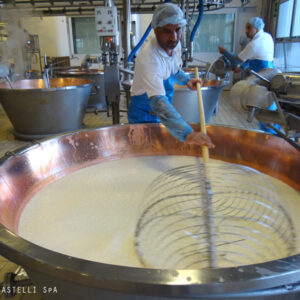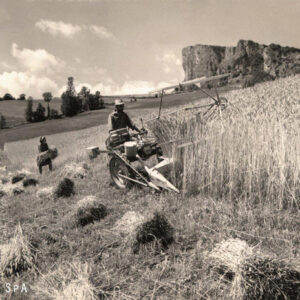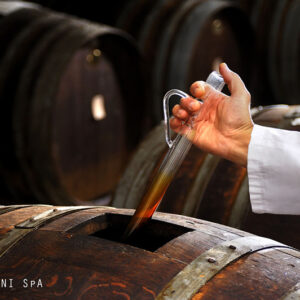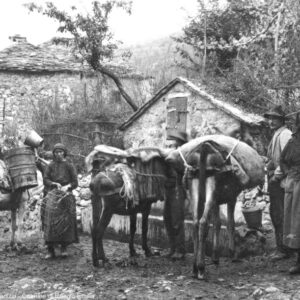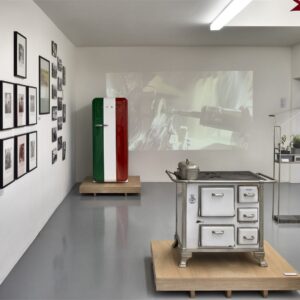NOI amiamo mangiare bene
Le ricette del Museo
Erbazzone
Nome in dialetto – In local dialect: scarpazzoun
“Scarpazzoun ed Erbazzoun sono la stessa cosa? Ogni reggiano sa che lo Scarpazzoun è tipico della sua città, mentre l’Erbazzoun, nome più generico, può essere gustato anche in altre città d’Italia. Differenza fondamentale tra i due è l’uso di ricotta nell’impasto dell’Erbazzoun che mancherebbe allo Scarpazzoun. All’inizio del secolo erano frequenti gare “scarapazzonesche”, per la precisione del migliore Scarpazzoun. Si svolgevano tra le cooperative di consumo con grande successo di pubblico.
Are Scarpazzoun and Erbazzoun the same thing? All locals from the Reggio province know that each town and area has its own unique Scarpazzoun, whereas Erbazzoun is a generic description which embraces similar products from other Italian cities. In Reggio Emilia both can be found and it appears that one of the fundamental differences concerns the use of ricotta in erbazzoun and not in Scarpazzoun.
Scarpazzoun competitions were popular at the beginning of the century, where the finest dish would receive due recognition. They were held by consumer cooperatives and were extremely popular.
Ricetta
Per la pasta esterna: 200 gr. di farina; 1 noce di strutto; sale. Amalgamare gli ingredienti per ottenere una pasta non troppo dura che intriderete con acqua fredda. Con questa pasta foderare una teglia ben unta, dai bordi abbastanza alti. Nel frattempo avrete lessato, strizzato molto bene e sminuzzato le bietole, le avrete rosolate in un battuto di prezzemolo, aglio, sale, pepe e spezie. Quando saranno ben insaporite, ritiratele dal fuoco aggiungendo abbondante parmigiano reggiano grattugiato ed un uovo intero per chilogrammo di composto. Ricoprite con altra pasta lasciandola leggermente arricciata e pressate bene i bordi tutt’attorno. Bucherellate la superficie con una forchetta e cuocete in forno ben caldo. Sulla pasta leggermente dorata posate qua e là dei fiocchetti di lardo con aglio e prezzemolo sminuzzati. Continuate la cottura per circa quaranta minuti.
“Iori Galluzzi M.A.–Iori N., Breve manuale del mangiar reggiano, Reggio Emilia, N. Iori, 1985, pag. 30”
For the pastry: 200 g flour; 1 knob of lard; salt. Mix the ingredients together and aim for a soft mixture to which water is then added. Thoroughly grease a pie dish with tall sides and unroll the pastry into it. In the mean time boil, thoroughly strain and finely chop the chard and sauté with some finely chopped parsley, garlic, salt, pepper and spices. Once flavoured, remove the pan from heat and add a generous amount of grated Parmigiano Reggiano and a whole egg per kilo of filling. Place the filling on the bottom layer of pastry and cover with the top layer of pastry, thoroughly press the sides and create a crumpled effect all around. Pierce the surface a few times with a fork and bake in a pre-heated oven. As soon as the pastry turns slightly golden, add a few shards of lard with finely chopped garlic and parsley. Continue baking for approximately forty minutes.
“Iori Galluzzi M.A.–Iori N., Breve manuale del mangiar reggiano, Reggio Emilia, N. Iori, 1985, pag. 30”
Compila il form sottostante e inviaci la tua ricetta![contact-form-7 id=”13594″ title=”Ricette”]
Mostra
temi
Noi governiamo l’acqua
Noi lavoriamo la terra
Noi alleviamo gli animali
Noi costruiamo comunità
Noi produciamo futuro
Noi amiamo mangiare bene
Ritratti di un paesaggio




